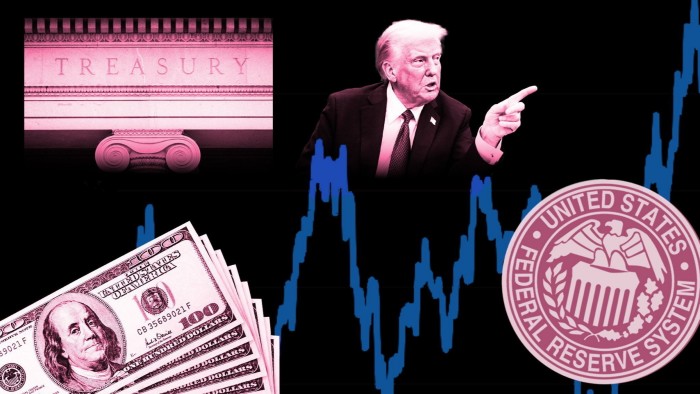Unlock the Editor’s Digest for free
Roula Khalaf, Editor of the FT, selects her favourite stories in this weekly newsletter.
“Trump trade” bets on a stronger dollar and higher bond yields have backfired this year as investors take a more bearish view on the economic fallout from the new US administration’s global trade war.
The US currency has slipped and Treasuries have rallied since early January, confounding widespread investor expectations that President Donald Trump’s plans for trade tariffs and tax cuts would keep inflation and interest rates high.
“Despite what it feels like, if you really zoom out to the beginning of this year, a lot of the [Trump] trades haven’t worked,” said Jerry Minier, co-head of G10 forex trading at Barclays. “That is causing people to reassess.”
Investors have pulled back from popular Trump trades partly because the president’s tariffs have so far been less aggressive than many feared. But many also worry that the uncertainty sparked by the stop-start trade war could begin to hurt confidence in the US economy, undermining the bullish market reaction to Trump’s election in November.
The “average menu” of popular trades, such as betting against the euro or the Chinese renminbi, has not rewarded investors this year, Minier said. “You continue to need reasons for the dollar [rally] to continue to extend — at least for now those things have been pulled away,” he added.

Bets that Trump’s inflationary policies would both give the Federal Reserve less room to cut interest rates and depress growth in US trading partners, helped drive a huge rally in the dollar. The US currency gained 8 per cent against a basket of its peers from late September until the end of the year.
Asset managers flipped to a net long dollar position in December for the first time since 2017, according to an analysis by CME Group of currency futures contracts. But so far this year the US currency has slipped 0.4 per cent.
Expectations of higher inflation also helped push 10-year Treasury yields, which move inversely to prices, to 4.8 per cent in January, their highest since late 2023.
But they have now fallen back to 4.54 per cent, as the market’s focus has switched from inflation to fears that the US’s buoyant economy could falter under the new president.
“There’s an underlying fear that growth might be slowing down,” said Torsten Slok, chief economist at investment firm Apollo, with a trade war “potentially having some growth implications”.
The bond market is “caught between a fear that inflation might be a little bit higher because of a trade war, and a fear that US growth or global growth might be slower”, said David Kelly, chief global strategist at JPMorgan Asset Management.
This month Trump backed down at the eleventh hour on threats to impose sweeping tariffs on Mexico and Canada, granting both countries a 30-day delay. But he pushed ahead with 10 per cent additional import tariffs on China, and late on Friday the president said he could also hit Japan with new levies, to tackle the trade deficit with the US’s most important ally in the Indo-Pacific.
He has also announced plans for 25 per cent tariffs on steel and aluminium imports.

Emerging markets, widely expected to be a particular victim of the trade war and a stronger dollar, have also defied expectations in recent weeks, after a grim 2024 in which some currencies touched multiyear lows.
Since the start of Trump’s second term last month, the Chilean peso has gained more than 3 per cent, while the Colombian peso and the Brazilian real are up more than 6 per cent against the greenback.
Bank of America strategists have turned positive on emerging markets in the belief that bets on a higher dollar, which is at its strongest in real effective exchange rate terms since 1985, are overstretched.
“It is about very extreme positioning, and a lot of tariff noise already being priced in,” said David Hauner, the bank’s head of global emerging markets fixed-income strategy.
“It’s not like it couldn’t get worse — of course, it could — but for the time being, given the back and forth of the last few weeks, we have priced in a fair amount.”
Investors say emerging market central banks have scope to cut borrowing costs to support economic growth, after aggressive rate rises in recent years to tackle inflation. Mexico, the Czech Republic and India all reduced rates last week.
Real interest rates — which are adjusted for inflation — are also higher in much of the developing world than in the US, making it profitable to borrow in dollars and invest in emerging markets.
“No matter how you slice or dice it, local currencies have become very, very cheap — even if the dollar doesn’t weaken from here, and it just stabilises,” said one emerging markets fund manager, who had just returned from Brazil looking for cheaply priced assets.
https://www.ft.com/content/d79cffed-d68f-4f4a-9a8c-31dcd60d5a5b


